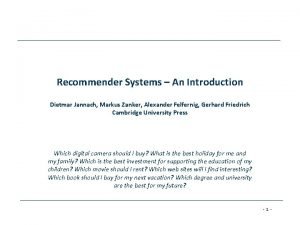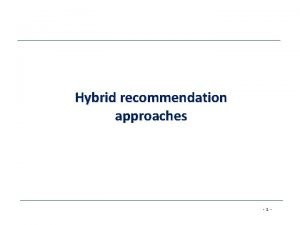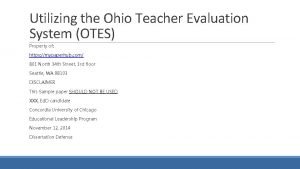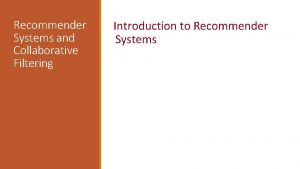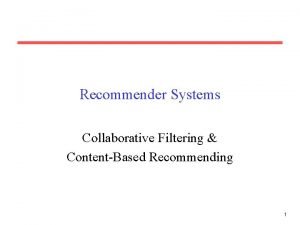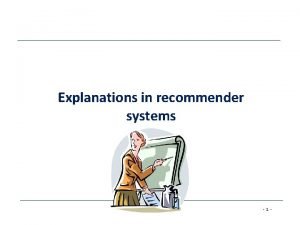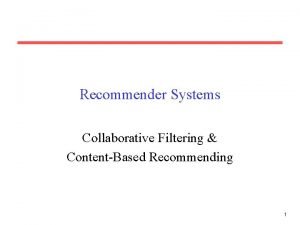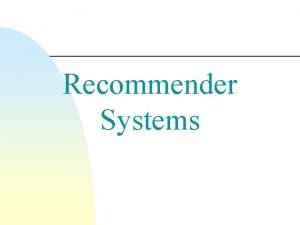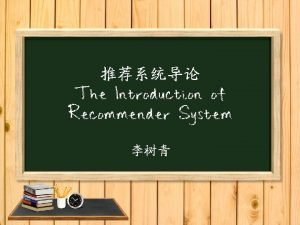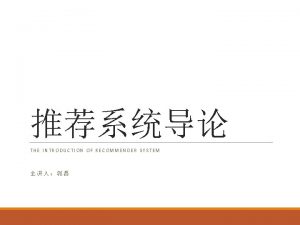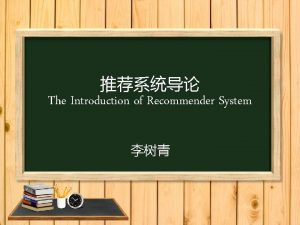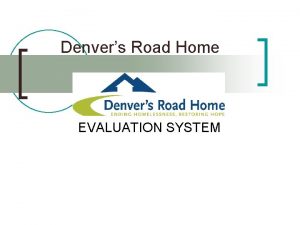The Introduction of Recommender System Evaluation of Recommender




















































- Slides: 52

推荐系统导论 The Introduction of Recommender System 李树青

第六章:推荐系统评价 • Evaluation of Recommender Systems

Questions • A technical method is efficient with respect to a specified goal? • • • Responsiveness to user requests Scalability Peak load or reliability Maintainability Extensibility Lowering the cost of ownership • Increasing customer satisfaction? • Ensuring the economic success of an ecommerce platform?

1 General properties






1. 1 Subjects: dataset • Natural datasets include historical interaction records of real users

Popular data sets


How to calculate Sparsity? • R = ratings • I = items • U = users

All kinds of results

Possible problem • Nevertheless, the results of evaluating recommender systems using historical datasets cannot be compared directly to studies with real users and vice versa • No assumptions can be made for all unrated items because users might not have been aware of the existence of these items • By default, these unknown item preferences are interpreted as disliked items and can therefore lead to false positives in evaluations












2 Evaluation on historical datasets

Example user ratings

Metrics

Mean Absolute Error (MAE) • The most popular measure

Precision • hitsu: number of correctly recommended relevant items for user u • The Precision metric (P) relates the number of hits to the total number of recommended items (|recsetu|)

Recall • The ratio of hits to theoretical maximum number of hits owing to the testing set size (|testsetu|)

• Measuring an algorithm’s performance based on Precision and Recall reflects the real user experience better than MAE does because, in most cases, users actually receive ranked lists from a recommender instead of predictions for ratings of specific items

Example • recset 234 ={ • • (912, 4. 8), (47, 4. 5), (263, 4. 4), (539, 4. 1), (348, 4), . . . , (719, 3. 8) } • MAE=0. 65 • only the five highest ranked items – P = 0. 2 – R = 0. 5

F metric • Effectively averages Precision and Recall with bias toward the weaker value

Rank scores • The rationale behind this weighting is that later positions have a higher chance of being overlooked by the user, even though they might be useful recommendations

half-life utility rank score

Example • user 234 with twenty recommendations and hits on the fourth and twentieth positions • a=10

lift index • It assumes that the ranked list is divided into 10 equal deciles and counts the number of hits in each decile as S 1, u, S 2, u, . . . , S 10, u

Example

3 Methods • The observed or measured aspects are termed variables • Either independent or dependent

Independent variables • A few variables are always independent (often static) • gender, income, education, or personality traits • Further variables are independent if they are controlled by the evaluation design • the type of recommendation algorithm

Dependent variables • Dependent variables are those that are assumed to be influenced by the independent variables • User satisfaction, perceived utility, or clickthrough rate

1) Experiment design

• Subjects are randomly assigned to different treatments • Different recommendation algorithms • The type of algorithm would constitute the manipulated variable • The dependent variables (e. g. , v 1 and v 2) are measured before and after the treatment

2) Quasi-experimental design • Lacking random assignments of subjects to different treatments • subjects decide on their own about their treatment

• Might introduce uncontrollable bias because subjects may make the decision based on unknown reasons • When comparing mortality rates between populations being treated in hospitals and those staying at home, it is obvious that higher mortality rates in hospitals do not allow us to conclude that these medical treatments are a threat to people’s lives

• There could be unknown reasons (i. e. , uncontrolled variables) that let users who have a strong tendency to buy also use the recommender system • some items that were rarely purchased in the period before the introduction of the recommendation system became top-selling items afterward and further analysis indicated that the increase in the number of pieces sold for these items correlated positively with the occurrence of these items in actual recommendations

3) Nonexperimental designs • Include all other forms of quantitative research, as well as qualitative research • asking users different questions about the perceived utility of a recommendation application with answers on a N-point Likert scale • qualitative research approaches would conduct interviews with open-ended questions

Longitudinal research, • The entity under investigation is observed repeatedly as it evolves over time

4) Cross-sectional research • Analyzing relations among variables that are simultaneously measured in different groups

5) Case studies • Analyzing empirical evidence • Answering research questions about how and why and combine whichever types of quantitative and qualitative methods
 Introduction to recommender systems
Introduction to recommender systems Recommender systems: an introduction
Recommender systems: an introduction Latent factors recommender system
Latent factors recommender system Recommender relationship
Recommender relationship Weighted hybrid recommender systems
Weighted hybrid recommender systems Hình ảnh bộ gõ cơ thể búng tay
Hình ảnh bộ gõ cơ thể búng tay Lp html
Lp html Bổ thể
Bổ thể Tỉ lệ cơ thể trẻ em
Tỉ lệ cơ thể trẻ em Chó sói
Chó sói Tư thế worms-breton
Tư thế worms-breton Bài hát chúa yêu trần thế alleluia
Bài hát chúa yêu trần thế alleluia Các môn thể thao bắt đầu bằng tiếng nhảy
Các môn thể thao bắt đầu bằng tiếng nhảy Thế nào là hệ số cao nhất
Thế nào là hệ số cao nhất Các châu lục và đại dương trên thế giới
Các châu lục và đại dương trên thế giới Công của trọng lực
Công của trọng lực Trời xanh đây là của chúng ta thể thơ
Trời xanh đây là của chúng ta thể thơ Mật thư tọa độ 5x5
Mật thư tọa độ 5x5 101012 bằng
101012 bằng Phản ứng thế ankan
Phản ứng thế ankan Các châu lục và đại dương trên thế giới
Các châu lục và đại dương trên thế giới Thơ thất ngôn tứ tuyệt đường luật
Thơ thất ngôn tứ tuyệt đường luật Quá trình desamine hóa có thể tạo ra
Quá trình desamine hóa có thể tạo ra Một số thể thơ truyền thống
Một số thể thơ truyền thống Cái miệng nó xinh thế chỉ nói điều hay thôi
Cái miệng nó xinh thế chỉ nói điều hay thôi Vẽ hình chiếu vuông góc của vật thể sau
Vẽ hình chiếu vuông góc của vật thể sau Nguyên nhân của sự mỏi cơ sinh 8
Nguyên nhân của sự mỏi cơ sinh 8 đặc điểm cơ thể của người tối cổ
đặc điểm cơ thể của người tối cổ V. c c
V. c c Vẽ hình chiếu đứng bằng cạnh của vật thể
Vẽ hình chiếu đứng bằng cạnh của vật thể Phối cảnh
Phối cảnh Thẻ vin
Thẻ vin đại từ thay thế
đại từ thay thế điện thế nghỉ
điện thế nghỉ Tư thế ngồi viết
Tư thế ngồi viết Diễn thế sinh thái là
Diễn thế sinh thái là Dot
Dot Số nguyên tố là gì
Số nguyên tố là gì Tư thế ngồi viết
Tư thế ngồi viết Lời thề hippocrates
Lời thề hippocrates Thiếu nhi thế giới liên hoan
Thiếu nhi thế giới liên hoan ưu thế lai là gì
ưu thế lai là gì Khi nào hổ mẹ dạy hổ con săn mồi
Khi nào hổ mẹ dạy hổ con săn mồi Khi nào hổ mẹ dạy hổ con săn mồi
Khi nào hổ mẹ dạy hổ con săn mồi Hệ hô hấp
Hệ hô hấp Từ ngữ thể hiện lòng nhân hậu
Từ ngữ thể hiện lòng nhân hậu Thế nào là mạng điện lắp đặt kiểu nổi
Thế nào là mạng điện lắp đặt kiểu nổi Introduction to monitoring and evaluation
Introduction to monitoring and evaluation Introduction of evaluation
Introduction of evaluation Conclusion of educational evaluation
Conclusion of educational evaluation Ohio teacher evaluation system
Ohio teacher evaluation system Ncoer senior rater narrative examples
Ncoer senior rater narrative examples Enlisted evaluation system
Enlisted evaluation system

